

Third-row Seat Access
Occupants can get into and out of the third-row seats easily by sliding the second-row seats forward.
Make sure there is nobody in the second-row seat area before operating a lever or pressing a switch:
Not checking the second-row seat area for persons before folding a seatback with a lever or switch is dangerous. The second-row seat area is difficult to see from the rear of the vehicle. Operating a lever or pressing a switch without checking could cause injury to a person when a seatback suddenly flips forward.
Do not operate the lever on the side of the head restraint or press the switch on the side of the seat under the following conditions:
Operating the lever on the side of the head restraint or pressing the switch on the side of the seat under the following conditions is dangerous as the seat may move unexpectedly and cause an injury such as a foot getting pinched between the seat and floor.
-
Occupant is seated in second-row seat


-
Second-row seatback is folded forward
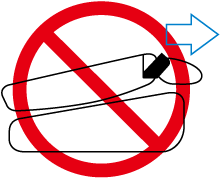
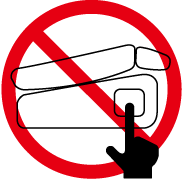
-
Child is seated on child restraint in second-row seat
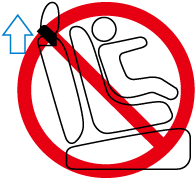
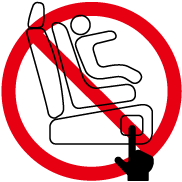
-
When operating the seat, be careful not to get your hand or foot caught, or hit your head.
-
Before moving the second-row seat, make sure that the head restraint is at the lowest position. If the second-row seat is folded forward while the head restraint is pulled up, there will not be enough space for getting in or out of the vehicle which could cause an occupant to trip and fall resulting in injury.
-
Check the position of a front seat before folding a second-row seatback.
Depending on the position of a front seat, it may not be possible to fold a second-row seatback all the way down because it may hit the seatback of the front seat which could scratch or damage the front seat or its pocket. Remove the head restraint on the second-row outboard seat if necessary.
Entering/exiting the third-row seat area
-
Lower the head restraint all the way down.
Refer to Head Restraints (Search).
-
(Lever)
Pull up the lever on the side of the head restraint to unlock the seat, fold the seatback forward, and slide the seat forward.

(Switch)
To unlock the seat, press the switch continuously until a sound is activated, release it, fold the seatback forward, and slide the seat forward.
When any of the following conditions is met, a beep sound is activated continuously and the switch operation is cancelled.
-
The door on the side where the switch was operated is closed.
-
The switch is pressed continuously for 5 s or more.
-
The vehicle is being driven.
-
The selector lever is in a position other than P, and the parking brake is off.
-
The battery has deteriorated.
-
There is a system problem.
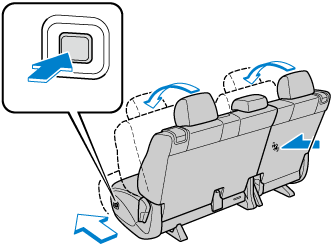
-
-
Do not operate the lever on the side of a second-row seat while the seatback is folded down and the seat is slid forward. If the lever is forcefully operated, it could damage the lever.
-
After entering/exiting the third-row seat area, return the second-row seatback to its upright position and lock it after sliding it rearward.
Make sure it is locked by attempting to lightly move it back and forth.
Otherwise, it could move unexpectedly and cause injury.
After getting in or out of the vehicle
Move the seatback rearward, slide the seat rearward, and lock the seat.
Entering/exiting the third-row seat area with child-restraint system installed (Right-side seat only)*1
Access to the third-row seats is possible even when a child-restraint system is installed to the second-row seat.
-
For left-hand drive models. Only for the left-side seat for right-hand drive models.
(Lever)
Pull up the lever on the side of the head restraint to lower the front side of the seat and slide the seat forward.
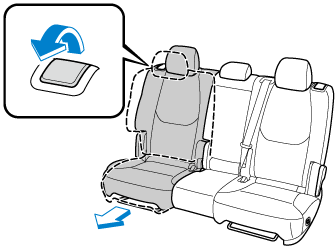
(Switch)
To unlock the seat, press the switch continuously until a sound is activated, release it, fold the seatback forward, and slide the seat forward.
When any of the following conditions is met, a beep sound is activated continuously and the switch operation is cancelled.
-
The door on the side where the switch was operated is closed.
-
The switch is pressed continuously for 5 s or more.
-
The vehicle is being driven.
-
The selector lever is in a position other than P, and the parking brake is off.
-
The battery has deteriorated.
-
There is a system problem.
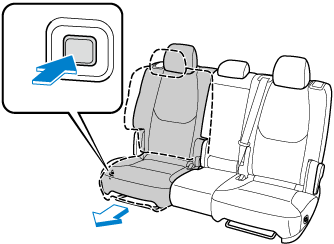
After entering/exiting the third-row seat area, lock the seat after sliding it rearward.
Make sure it is locked by attempting to lightly move it back and forth.
Otherwise, it could move unexpectedly and cause injury.
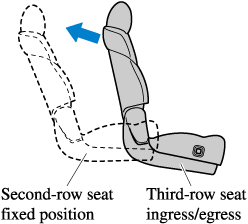
The second-row seat cannot be moved forward while the seat belt is securing the child-restraint system.
After getting in or out of the vehicle
Move the seatback rearward, slide the seat rearward, and lock the seat.




